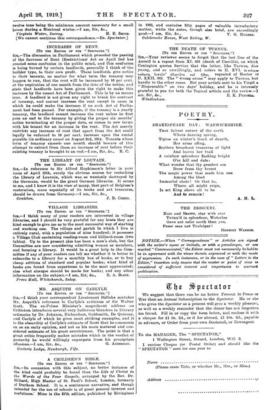[To ma Earroa or me " Eirrarrros.") Sut,—As an architect
who has practised in Canada for nearly twenty years, may I correct certain statements made by one of your correspondents in your issue of April 12th under the heading "Hollow House-Walls "? I am afraid Mr. Crane's memory has played him false, or he has been misinformed as to the details of construction. The system of building which he describes is known as "Brick Veneer," and was common in Canada some years ago, until forbidden by Municipal. Building Regulations as being very inflammable. It consists. in effect of a frame house, the walls of which are built of 2 in. by 4 in. or 2 in, by 6 in, studs at 16 in. centres, lathed and plastered inside, covered with boarding and paper outside, against which a 41 in. brick wall is built, and secured to the frame- work by spikes driven in at intervals. The warmth of this kind of construction is entirely due to the air space enclosed between the plaster on one side of the framework and the paper on the other—the air is thus enclosed between two non- porous materials, and not, as your correspondent would lead a layman to suppose, having brick alone on the outside, which being porous would be quite unsuitable. In this type of con- struction the brickwork adds nothing to the stability or warmth of the structure, but is merely added for appearances. The amount of coal mentioned as being adequate for the size of house in question also requires considerable correction,
twelve tons being the minimum amount necessary for a small house during a Montreal winter.—I am, Sir, b.c., Virginia Water, Surrey. H. E. Swim. [We cannot oontinue this correspondence.—En. Spectator.]







































 Previous page
Previous page